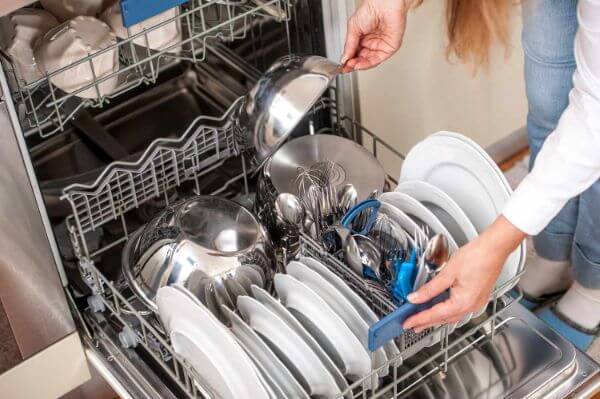Loading a dishwasher may seem like a simple task, but if it’s not done properly, dishes may not be cleaned effectively and could potentially damage the dishwasher.
Here are some tips for properly loading a dishwasher to ensure maximum cleaning performance:
- Scrape and rinse dishes before loading: Remove any large food particles from your dishes and rinse them before loading into the dishwasher. This will prevent food debris from clogging the dishwasher and ensure your dishes come out clean.
- Load dishes properly: Load the dishes in the dishwasher with the dirty side facing towards the center of the dishwasher. This will ensure proper cleaning of the dishes and prevent any damage from occurring.
- Avoid overcrowding: Overcrowding the dishwasher can prevent proper water flow and can lead to dishes not being cleaned properly. Ensure that dishes are loaded with enough space between them to allow for proper water flow.
- Load dishes in the right positions: Place plates and bowls on the bottom rack with their soiled sides facing the center of the dishwasher. Cups, glasses, and smaller items should be placed on the top rack with their open ends facing down.
- Place utensils in the utensil holder: Utensils should be loaded into the utensil holder with their handles facing down to ensure proper cleaning. When loading silverware in a dishwasher, place them in the utensil holder with the handles facing down. Mix utensils to prevent nesting and ensure proper cleaning.
- Check the spray arm: Ensure that the spray arm can rotate freely before starting the dishwasher. This will allow for proper water flow and cleaning of dishes.
- Add dishwasher detergent: Add the correct amount of dishwasher detergent according to the manufacturer’s instructions. Using too much detergent can lead to poor cleaning results and can damage the dishwasher.
- Use the appropriate cycle: Select the appropriate cycle for the type of load you’re washing. For example, a heavily soiled load may require a longer wash cycle.
- Unload the dishwasher properly: After the dishwasher has completed its cycle, allow the dishes to cool for a few minutes before unloading. This will prevent any burns from hot dishes.
By following these tips, you can ensure that your dishwasher is loaded properly, and your dishes are cleaned effectively. Proper loading can also help to extend the life of your dishwasher and prevent any damage.
Don't Miss:
Café CDT805 Dishwasher Review
Dishwasher Pods vs. Liquid: Decoding the Best Cleaning Solution
Is LG Studio Dishwasher Any Good?
Miele vs. Beko Dishwashers
Dishwasher Gel vs. Pods: Which is Better For Clean Dishes?
Midea vs Bosch Dishwasher
Maytag vs Whirlpool Dishwasher
Does Eco Mode on Dishwasher Save Electricity?
